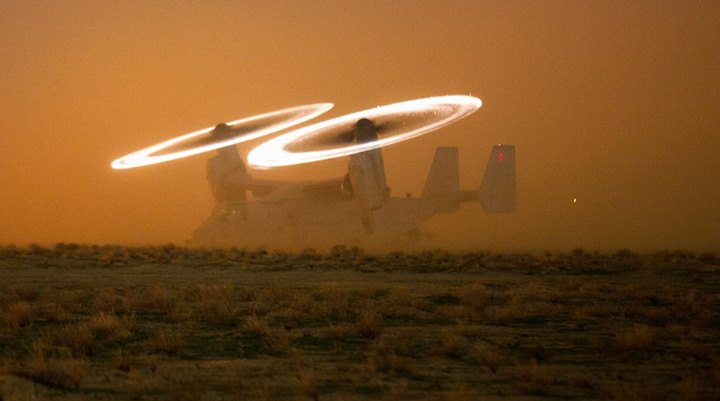A U.S. Marine Corps Osprey tilt-rotor aircraft is depicted with seemingly solid rotor disks.
The image in this post shows a U.S. Marine Corps MV-22 Osprey assigned to Special Purpose MAGTF – CR – CC during a TRAP (tactical recovery of aircraft and personnel) drill at an undisclosed location in Southwest Asia, on Nov. 16, 2015.
What makes the shot particularly interesting (and vaguely Star Wars-like…) is the halo effect caused by the sand hitting the blades and eroding their metal surface. The effect is more visible around the blades’ tips where the peripheral speed is higher.
Caused by the oxidation of eroded particles, the so-called “Kopp-Etchells effect” (named by war correspondent Michael Yon after Cpl. Benjamin Kopp, and Cpl. Joseph Etchells, two fallen American and British soldiers) makes the tilt-rotor aircraft more visible from distance, hence more vulnerable.
Here are some interesting details included in a paper by Warren (Andy) Thomas; Shek C. Hong; Chin-Jye (Mike) Yu; Edwin L. Rosenzweig titled “Enhanced Erosion Protection for Rotor Blades” presented at the American Helicopter Society 65th Annual Forum, Grapevine, Texas, May 27 – 29, 2009″:
To prevent damage from rain or sand erosion, metallic abrasion strips, typically composed of stainless steel or titanium, are bonded to the blade leading edge to serve as a hard surface that absorbs the kinetic energy of the rain drop or sand particle. Metallic structures are especially good at rain erosion protection. Impacting sand particles, however, slowly erode away the metallic material. This is especially true near the outboard blade tip, where the high blade velocity ensures that the sand particles impact with greater kinetic energy. In this area, a metallic cap that is more durable to sand erosion, often composed of electro-formed nickel, is often bonded to the abrasion strip. Damaged abrasion strips and caps may be replaced to refurbish rotor blades; but this requires removal and repair at a depot, increasing maintenance cost and reducing fleet operational readiness.
A secondary concern with the erosion of metal abrasion strips pertains to the visible signature that occurs when microscopic metallic pieces are eroded away. In the erosion process, they often oxidize, giving off a visible spark and causing a corona effect in sandy environments.
In other words, when the metallic abrasion strips hit sand, a visible corona or halo around the rotor blades is generated. This is obviously more likely to happen when the aircraft flies low and its rotor wash blows more sand in the air. The visual effect, similar to that of sparks made by a grinder, is caused by the pyrophoric oxidation of the ablated metal particles.
H/T @DCDude1776 for the heads-up








